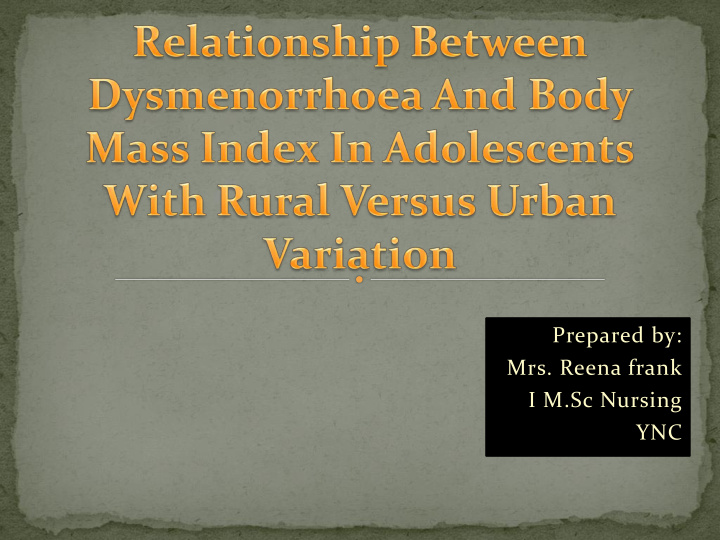



Prepared by: Mrs. Reena frank I M.Sc Nursing YNC
Dysmenorrhea refers to a cyclic lower abdominal or pelvic pain which may radiate to the back or to the thighs, occuring during menstruation. Primary dysmennorhoea: cramping pain the lower abdomen occuring at the onset of menstruation in the absence of any identifiable pelvic diseases.
Secondary dysmennorhea: painful menses resulting from a identifiable pelvic pathology like fibroid, PID etc. Etiology of primary dysmennorhoea was not precisely understood, but most symptoms can be explained by the action of prostaglandin, particularly PGF2 alpha which is released during endometrial sloughing Primary dysmenorrhoea usually present during adolescence within 3 years of menarche
Sample : adolescence girls 12-18 years Design: cross sectional Sample size: 400 : - rural area 200 and urban area 200 Inclusion criteria: have attained menarche at least 6 months back Tool: self administered questionnaire
Rural setup: Mild :52% Moderate: 26.5% Severe: 3% Urban set up: Mild :56.5% Moderate: 12.5% Severe: 7%
Prevalence of dysmenorhoea 81.5% in rural setup 76% in urban setup Rural area: Under weight: 66.5%, BMI-less than 16.5 Under weight: 14.5%, BMI- not less than 16.5 normal BMI 19% Urban area: Under weight: 38.5%, BMI-less than 16.5 Under weight: 33.5%, BMI- not less than 16.5 normal BMI 28%
Rural area: Mild & moderate : less than 16. 5 BMI 27.18% under weight 0.97% normal BMI & no dysmennorrhoea Urban area: Severe : less than 16. 5 BMI 54.86% under weight 7.07% normal BMI & no dysmennorrhoea
Study aims to establish the relationship between Dysmenorrhea and BMI. Prevalence of dysmenorrhea in the study found to be very high with 81.5 % rural girls and 76% urban girls suffering from it. Majority of the girls in this study were found to have low BMI indicating the poor nutritional status among our adolescence, particularly in the rural setup.
Dysmenorrheal had its impact on the daily activities of girls leading to school absenteeism. In this study the relationship between dysmenorrhea & BMI found to be highly significant “p<0.001” with increased prevalence of dysmenorrhea in the law BMI group.
The prevalence of dysmenorrhoea in adolescence girls is very high, resulting in disruption of their social & personnel activities. Also Indian adolescence have a very poor nutritional status, as reflected by their law BMI.
Recommend
More recommend